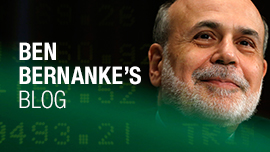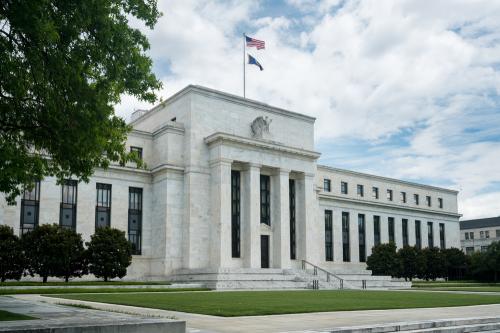This is the second of three posts based on my recent Mundell-Fleming lecture at the International Monetary Fund (see here for a video of the lecture and here for a paper that elaborates on the lecture’s themes).
In the first post of the series, I challenged the claim that in recent years the U.S. (via the Fed) has waged a “currency war,” seeking competitive advantage in trade by easing monetary policy and thereby weakening the foreign exchange value of the dollar. In this post I address a more subtle criticism of U.S. monetary policy: that changes in the Fed’s policy stance (tightening as well as easing) have had adverse effects on global financial markets, particularly markets in developing economies. Clearly, the Fed would not intentionally seek to destabilize financial markets, but if “financial stability spillovers” of U.S. monetary policy are in fact significant, they pose potential problems for both the U.S. and its trading partners.
An example often cited in discussions of financial stability spillovers is the so-called “taper tantrum” of 2013. In May and June of that year, in my capacity as Fed chair, I publicly raised the possibility that the central bank could begin “later this year” to slow the pace of its asset purchases, initiated in the round of quantitative easing known as QE3. Although I was careful to say that short-term interest rates would remain low for a long time even after the “tapering” of asset purchases had begun, some market participants evidently interpreted statements by me and others at the Fed as signaling a possibly imminent rise in rates. The market volatility resulting from this shift of expectations—the “tantrum”—was felt particularly strongly by emerging-market economies. Emerging markets also experienced sharp outflows of financial capital (“hot money”), as international investors sought greater safety. The U.S. economy did not seem to be much affected by these developments, as growth continued in late 2013 and 2014, but some emerging-market economies came under stress, especially the so-called “fragile five”: Turkey, Brazil, India, South Africa, and Indonesia.
Global financial linkages are nothing new, of course, but the ongoing liberalization and growth of international trade and finance have likely made those linkages tighter and more consequential, particularly for developing economies. Illustrating the extent of financial integration, in recent work economist Hélène Rey (see here and here) has found evidence of a “global financial cycle,” a tendency of risky asset prices around the world to move together. In particular, she and others find that international investors appear subject to sharp swings in sentiment: During “risk-on” periods, according to this research, financial capital flows into emerging markets, leading to increases in risky asset prices, faster credit growth, and more leverage. This process can reverse sharply during high-volatility “risk-off” periods, with possibly adverse economic as well as financial effects. Although various factors can cause changes in market risk preferences, Rey and others find that U.S. monetary policy is one trigger of such shifts, with easier Fed policy tending to be followed by greater risk appetite and vice versa.
This line of research is interesting and important. Given the sometimes severe consequences of financial instability, we have to take these issues very seriously. Unfortunately, we don’t understand these phenomena as well as we would like. In particular, the existence of a “global financial cycle” in itself doesn’t tell us very much about the extent to which the financial correlations across countries reflect relatively benign factors—adjustment to common economic shocks, capital flowing toward higher-productivity uses, or normal portfolio rebalancing and hedging, for example—and how much they reflect more malign influences, such as cognitive biases, inadequate risk controls, weak institutions, limited market liquidity, or poor regulation. Moreover, not all financial volatility is created equal: Financial swings in some cases are no more than a headache for traders (or, sometimes, even a short-term profit opportunity) with little lasting economic effect. However, in other circumstances, as we saw during the global financial crisis, financial instability can do enormous economic damage. A lot more work is needed to clarify both the sources and the economic consequences of the global financial cycle and the apparent instability of international capital flows.
Policy decisions can’t wait for a full resolution of these debates, however. Based on what we know now, I see at least two broad issues that policymakers must grapple with: 1) the appropriate division of labor between policymakers in the U.S. and those of its trading partners, and 2) the role of monetary policy (as opposed to other policy tools) in promoting global financial stability.
On the roles of U.S. and non-U.S. policymakers: Both have critical responsibilities for making the international financial system work better, I believe. In particular, we should reject any presumption that emerging-market policymakers are helpless in the face of supposedly overwhelming pressures from global financial markets. To the contrary, there is strong evidence, cited in my paper, that emerging-market countries differ significantly in their sensitivity to global financial developments, and that these differences are often tied to differences in policy, including macroeconomic, structural, regulatory, and exchange-rate policies. Emerging-market policy choices do matter! These findings suggest that even those countries perceived as “fragile” can help themselves, while also helping to enhance global stability, by working to increase their economic and financial resilience over time. That involves upgrading financial regulation and supervision, strengthening market infrastructure, and adopting prudent macroeconomic (monetary and fiscal) policies. Mexico is an example of an emerging-market economy whose sound policies have allowed it to navigate recent bouts of financial volatility reasonably well, despite the country’s proximity to and economic integration with the United States.
Importantly, the “upgrading” that I am recommending does not necessarily involve continuous liberalization of financial markets: Rapid financial liberalization can be dangerous for emerging-market economies if the supporting institutions and regulatory mechanism are not adequate, and so sequencing of reforms is critical. For example, allowing banks unrestricted access to international markets for short-term funding (thereby exposing them to “hot money” risks) should come after the development of effective bank supervision, not before. Meanwhile, the best contribution that U.S. policymakers can make is to support and cooperate with international policy efforts, particularly in financial regulation and supervision. The U.S. has as much interest in the stability of global financial markets and financial institutions as its trading partners do, and we should be prepared to work closely with others in establishing international rules and in sharing supervisory information as needed.
What about monetary policy? The Fed already tries to take into account the feedback effects of financial volatility on its employment and inflation objectives, and when taking policy actions it tries not to surprise markets more than necessary. Beyond that, should the possibility of international spillovers from its monetary policy choices affect Fed decision-making? And, likewise, should emerging-market central banks make heavy use of monetary policy (including exchange-rate policy) in addressing financial stability concerns?
The tradeoffs that financial stability risks pose for monetary policy in the global context are closely analogous to the tradeoff that policymakers face domestically, as when the Fed or other central banks debate whether interest rate decisions should reflect financial stability goals as well as inflation and employment objectives. My long-held view is that, in general, monetary policy should not be diverted (at least not by very much) from its inflation and employment goals for financial stability reasons. The reason is simply that doing so usually does not pass the cost-benefit test, as recent research confirms (see here, here, and here). Under most circumstances, monetary policy is just too blunt a tool to use for financial stability purposes; it cannot be directed at some classes of financial assets and not others, or at financial markets only and not the real economy. Using monetary policy to manage financial stability risks is like trying to play the piano with a sledgehammer.
Besides the difficulty of using monetary policy in a carefully targeted way to reduce systemic risks, two additional factors make the cost-benefit calculus unfavorable. First, in general, we have a poor understanding of how the stance of monetary policy bears on risks to financial stability—sometimes we are not even sure of the sign of the effect. Second, even in those cases in which we think we understand the linkages between policy and financial stability, the change in monetary policy needed to have a meaningful effect on financial risks to the economy (by deflating a bubble, for example) is likely to be very large, so that the use of monetary policy in this way is also likely to lead to costly deviations of output, employment, and inflation from policymakers’ objectives. In the international context, the stability of the U.S. economy is of great importance to U.S. trading partners, and diverting Fed policy from that goal is really not in anybody’s interest. Likewise, emerging-market central banks that use monetary policy to target asset prices, say, give up a critical degree of freedom in managing domestic demand, output, and inflation.
To be clear, I am not in any way suggesting that financial stability risks should be ignored by policymakers. Risks to financial stability that could damage the broader economy should be addressed as effectively and proactively as possible. Policies targeted directly at the problem, such as financial regulation and so-called macroprudential policies, should be the first line of defense against financial instability. Moreover, as I’ve already noted, efforts to ensure financial stability should be international in scope, with both advanced and emerging-market economies participating actively.
What if those more-targeted policies prove ineffective, even after sustained effort and experimentation? Should we turn next to using monetary policy for these purposes? While standard economic arguments imply that giving literally zero weight to financial stability concerns in making monetary policy can’t be optimal, I worry that a significant diversion of policy for such reasons would amount to letting the tail of finance wag the economic dog. Finance should serve the economy, not vice versa. Given the substantial costs and difficulty of using monetary policy to ensure financial stability, it seems to me that, if targeted policies fail, we would be better served by considering structural changes to the financial system as needed to reduce the risks to the broader economy. For example, the International Monetary Fund has recently embraced the idea that (temporary) barriers to short-term capital flows might be desirable for emerging markets in which financial and institutional development is not yet at the level needed for the country to benefit from such flows. Whether such measures make sense for a given economy should be determined—much like decisions about how best to use monetary policies—by a hardheaded comparison of costs and benefits.
Comments are now closed for this post.
The Brookings Institution is committed to quality, independence, and impact.
We are supported by a diverse array of funders. In line with our values and policies, each Brookings publication represents the sole views of its author(s).




Commentary
Tantrums and hot money: How does Fed policy affect global financial stability?
January 6, 2016